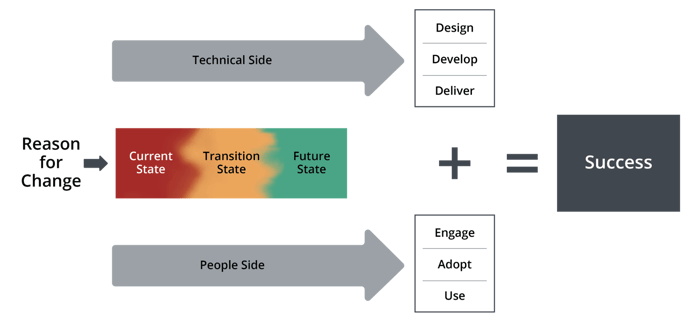A Roadmap for Building an Organizational Change Management Capability

3 Mins
Updated: August 11, 2025
Published: October 19, 2022

With the increasing pace and importance of organizational changes today, the ability to "out-change" your competition is an essential core competency. To successfully build your organization's change management capability, so you are agile and prepared, you must manage the effort like a project and a change. Prosci's ECM Roadmap gives you the direction you need.
Prosci's ECM Roadmap Tool
Over the last decade, the discipline of change management has emerged and evolved. What was once an ad hoc approach consisting of perhaps a communication plan and training plan has grown into a discipline driven by structure, rigor, process and deliverables. Leading organizations are now beginning to make the shift from applying change management in a project-by-project fashion toward institutionalizing and embedding change management to build a true organizational capability.
Prosci calls this effort enterprise change management (ECM) and has a suite of tools to support change management practice leaders undertaking this effort. Read on to learn about the Prosci ECM Roadmap, a structured process for creating effective strategies and plans to build an organizational change management capability.
Once you made the case and built commitment for building an organizational change management capability, the next step is to get started on building a structured and intentional approach for moving forward. If you are still working to build a case for enterprise change management, the Example Business Case for Enterprise Change Management offers tips and a template you can use to present the rationale and approach for building organizational change management capability in a clear and structured way.
ECM Roadmap Foundation
The foundation of the ECM Roadmap is this simple but critical observation: building an organizational change management capability is a change in and of itself. Making change management an expected and commonplace element of initiatives in the organization—or part of the DNA of the organization—is a project and its own change. Building an organizational capability must be managed as such. Although this may sound like common sense, it provides a critical perspective and foundation for the journey ahead when you are working to build a change management capability.

To support this shift in thinking, the Prosci ECM Roadmap tool applies a simple but powerful change framework. Any organizational change, whether it is a new safety procedure, an enterprise resource planning (ERP) application, or a location change, can be broken into five elements:
- Current state - how things are done today
- Future state - how things are done once the initiative is fully implemented
- Transition state - how we move from the current state to the future state
- Technical side - the systems and mechanisms required to reach the future state
- People side - building the support and buy-in that is needed to reach the future state
When you start the journey of building an organizational change management capability, this simple framework of change will provide critical direction to the effort. Without this perspective, practitioners fall into the trap of merely chipping away at training more people in change management and applying it to projects in an ad hoc manner. While some progress can be made with this approach, these practitioners have not yet made the crucial shift necessary to build a true capability. Structuring the effort as a change and a project to be managed is required to create a true organizational change management capability.
Structure and Activities
The Prosci ECM Roadmap is structured around this change framework. The tool's menu (shown below) mirrors the Current-Transition-Future State model.
1. Project ECM overview
Activities:
- Treating the effort to build organizational change management capabilities and competencies as a project and as a change: Project ECM
- Clarify the difference between "change management" and "enterprise change management"
- Start laying the foundation for Project ECM. Clarify the project definition, description and scope
- Make the case for change management and a case for enterprise change management
Tools:
- Project ECM Project Plan Template
- "Connecting the Case for ECM to Your Organization" Template
- "Why Project ECM" Template
- Project ECM Roadmap Checklist
2. Assess current state
Activities:
- Evaluate where you are currently in the Prosci Change Management Maturity Model
- Assess how changes happen in your organization
- Assess "Help or Hinder Factors" for ECM deployment
- Assess current view of change management
- Identify risk areas and key takeaways
- Apply findings as input to design
Tools:
- Prosci Change Management Maturity Model Audit and Whitepaper
- Project ECM Current State Environmental Analysis Assessment
- How Changes Happen Worksheet
- Help or Hinder Worksheet
- People-side Analysis Worksheet

3. Define future state
Activities:
- Complete a "standing in the future" exercise
- Establish maturity level goals
- Write ECM Vision Statement
- Define Technical Side, Future State elements
- Define People Side, Future State elements
- Write Project ECM Objectives
- Create Future State metrics
Tools:
- "Standing in the future" Worksheet
- Maturity Model Goal Template
- Project ECM Future State Metrics and Indicators Template

4. Design transition – technical side
Activities:
- Conduct gap analysis
- Identify your starting point
- Identify your default view
- Develop leadership tactics
- Develop project tactics
- Develop skill tactics
- Develop structure tactics
- Develop process tactics
- Create overall phased plan
Tools:
- Project ECM Gap Analysis Tool
- ECM Strategy Map Table
- ECM Strategy Map Starting Point Template
- ECM Strategy Map Plan Tool
5. Design transition – people side
Activities:
- Apply Prosci 3-Phase Process to create strategies and plans
- Develop Awareness-building tactics
- Develop Desire-building tactics
- Develop Knowledge-building tactics

- Develop Ability-building tactics
- Develop Reinforcement-building tactics
Tools:
- OCM for ECM Tracing Tool
- Audience Identification Worksheet
- Project ECM ADKAR Analysis tool
6. Managing project ECM as a project
Activities:
- Conduct Prosci PCT Assessment of Project ECM
- Establish plan for future Prosci PCT Assessment
- Use project tools (statement of work, charter, project plan, business case, etc.)
- Incorporate best practices
Tools:
- Project ECM PCT Assessment
- PCT Action Item Template
- PCT Over Time Assessment Tool
- ECM Best Practices Checklist Tool
Bring ECM to Your Organization
When you set out on your ECM journey, it's important to remember that building change management capability is it's own change to be managed. Building a true organizational change management capability takes structure and intent, including the roadmap, processes and tools you need for success.




